|
 |
Punch mark of the famous
Prussian jeweler and order decorations maker
Hossauer. (Mark on the lower cross arm of a
Red Eagle Order 3rd class 2nd model) |
|
 |
Mark of the gold
manufacture Humbert & Sohn in Berlin. They were in
business from 1799 on and competed with Hossauer.
In business until approx. 1865. |
|

 |
Punch mark of the famous
Prussian jeweler and order decorations maker
Hermann Julius Wilm, born January 27,
1812, to 1907, on the cylinder of a Red Eagle Order 3rd
class last model. Below the famous double
scratched W mark on a Red Eagle Order 3rd class
from around 1850. 1844 Court Jeweler. |
|
 |
Punch mark of the famous
Prussian jeweler and order decorations maker
Wagner next to the marking: 938 for the silver
content mark "938". (lower cross arm of a 3rd
class Silver gilt Order of the Crown with swords). |
|
 |
Another example of a punch
mark "W" from Wagner next to the marking: 938 for
the silver content mark "938". (lower cross arm of
a silver gilt
Pour le Mérite). |
|
 |
Scratch mark AW for Emil
August Wagner. Born April 30, 1826. Did learn his
work working for Hossauer in-between 1842 and
1846. Promoted to become Court Jeweler for the
Prussian in 1856. He bought together with F.L.J.
Sy the old Hossauer shop in 1856. (Mark on lower
cross arm of a Red Eagle Order 2nd class) |
|

|
Scratch Mark of the Gold- and Silver Business
of Hanff & Zimmermann. Founded
1842. Friedrich Gustav Zimmermann passed away
March 6, 1863. Found on a Red Eagle Order 1st
Class, model 1830-46 |
|

|
Potentially: Willibald Kluge & Co.
Order Decorations Manufacturer in Berlin und
supplier of Red Eagle as well as Crown Orders.
Here a Crown Order 3rd Class. |
|
 |
Unknown makers mark on a
Red Eagle Order 3rd class 2nd model. Please help
to identify this one. |
 |
|
Red Eagle Order
4th class last model
|
 |
|
House Order of
Hohenzollern knights cross with swords
|
|
This scratch mark
can be found on pieces made by the Brothers
Friedländer. They incorporated the firm from Zadek
S. Friedländer (June 26, 1801* - March 01, 1861+)
and run their business 1867 at Schloßplatz 13 in
Berlin. They become court jewelers within the same
year and start a Orders making firm at Unter den
Linden 28 in Berlin. This company was together
with the Johann Wagner & Sohn court jewelers the
main source for orders and medals for the Prussian
Orders Chancellery. Their punch mark can be found
on various order decorations such as Red Eagle
order or the
Pour le Mérite.
|
|
 |
Goldsmith J.H.
Werner run his company Berlin at Unter den Linden 1 separate from his
shop in Friedrichstr. 173. His mainly supplied
decorations of the 4th class of the Order of the
Crown and the Red Eagle Order to the General
Orders Commission. |
|
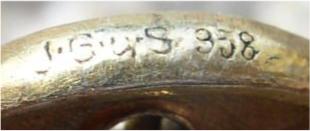 |
In 1761 the
Godet
firm was founded by Jean Godet. The Godet firm was
one of the earliest order decoration jewelers in
Germany. Under the management of Jean Fredric
Godet the company became court jeweler to the
Prussian Kings in 1828.
The Godet family ran
the business as J. Godet & Söhne from
approximately 1864 to sometime after 1924, when
the name changed to Eugen Godet & Co. In the late
1920th early 1930th the name
changed again to Gebrüder Godet & Co.Above the marking
on a Silver gilt PlM. The marking shown on the bottom
was found on a real golden PlM made by Godet. |
|
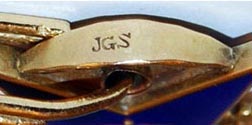
|
|
 |
This maker on a
Prussian Crown Order 3rd class stands for
Willibald Kluge & Co. His shop was at Leipziger
Strasse 71-72 in Berlin. He mainly fabricated Red
Eagle and Crown Orders 4th class as well as some
3rd class crosses of the Order of the Crown. |
|
 |
Scratch mark for the orders
and decorations manufacturer Neuhaus &
Sohn,
Morenstrasse 47 in Berlin. Well known for Red
Eagle Order as well as Crown Order decorations
especially in their 4th and 3rd class. Started
business in 1885. Here a Red Eagle Order 3rd
class. |
|

 |
Top picture shows a quite
rare scratch mark on a real golden House Order of
Hohenzollern knight badge with swords made by Sy &
Wagner. The bottom picture is on the Silver gilt
example from after 1916. The company Sy & Wagner
existed until the First World War. Jeremie Sy and
Albert Wagner took over the business from J.G.
Hossauer in 1859. |
|
  |
Punch mark of the
Mecklenburg jeweler: H. Rose (Reverse of a Griffin
Order pin back cross (left) and needle of a
commander star right)) |
|
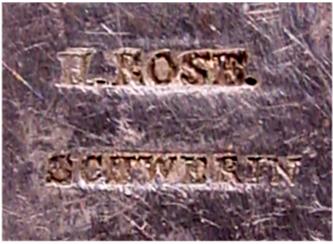 |
Punch mark of the
Mecklenburg jeweler: H. Rose on the reverse of a
grand cross star of the Mecklenburg Schwerin type
House Order of the Wendische Crown. |
|

|
The mark "D"
stands for doublée and indicates that a piece
is not made from gold, but is "doubliert"
meaning gilt. Baden uses it on all order
decorations made this way during World War one. |
|
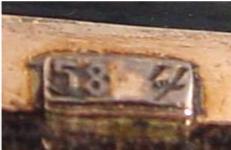 |
Marking on a separate
golden plate attached to a cross arm of the Baden
Order of the Zaehringer Lion Commander Cross with
swords WWI issue: Court jeweler Zimmermann, the 58
was meant to be a 585 to show the gold content.
Sometimes those markings did slip and aren't fully
readable. |
|
 |
Marking on a Saxon
Commander Cross of the Military Order of St. Henry
WWI issue: "R"
Alfred Roesner was promoted
to Court Jeweler in 1912 and became official
orders decoration supplier to the Saxon Orders
Chancellery in 1915. |
|
 |
Signet plate on the reverse
of a Saxon Order of Albert 1st type Grand Cross
Star of the manufacturer G.A. Scharffenberg in
Dresden. Approximately 1860. |
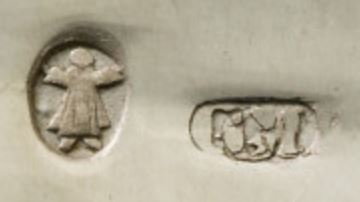 |
Hallmark of the Munich silversmith guild and
the master's mark "GM" for Gottfried Merck
(1786 – 1825), court jeweller as of circa 1820. On
a Commander Breast Star of the Order of St George,
1822 |
|
 |
Adam Hausinger was situated
in Munich and is known for some early Bavarian
order decorations. The mark to the left was found
on a Military Merit Cross 1st type made in the
timeframe of 1866 to 1870. |
|
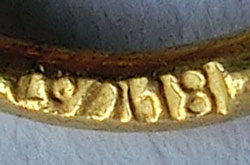
|
Eduard Quellhorst is
another Bavarian pioneer crafting order decorations
for the royal family. The mark on the ring of an
Michael Order knight 1st class 1st type shows the initials EQ
and the gold content of 18 carat. Eduard Quellhorst
(1806 – 1875) manufactured from 1838 – 1868 in Munich
(Augustinerstrasse first then Windenmachergasse). |
|
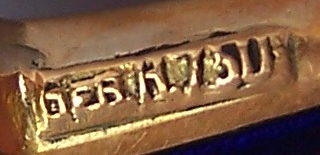
|
Mark found on a Military
Merit Order 2nd class with swords. GEB.H.750
stands for a decoration made by the Brothers Hemmerle
in 750/1000 parts gold. |
|

|
The Rosenthal mark has
crossed my path on only 2 different breast
stars. The one to your left comes from a very
early Oldenburg grand cross star. The other one
was seen on an Anhalt Albert the Bear
grand gross star. |
|
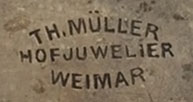 |
T.H.Mueller was court jeweler
and order manufacturer to the grand dukes of
Saxe-Weimar. He manufactured most of the
decorations of the Order of the White Falcon
since about 1870. The mark to your left is on a
grand cross star with swords from WWI. |





